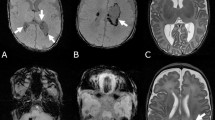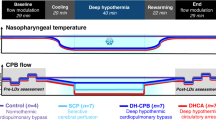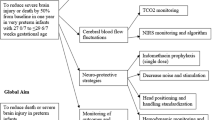Abstract
Background
Preterm neonates are vulnerable to impaired cerebrovascular autoregulation (CAR), with a risk of developing cerebral injury (intraventricular hemorrhage or periventricular leukomalacia). In this meta-analysis, we evaluate the association between the degree of CAR and cerebral injury in preterm neonates, using various CAR assessment techniques mainly based on near-infrared spectroscopy.
Methods
We systematically searched PubMed and EMBASE between 01-05-2023 and 31-01-2024. We included original articles published between 2000-2023, reporting CAR and cerebral injury in preterm neonates. The study was registered in PROSPERO (ID: 427323). We assessed the standardized mean difference in degree of CAR in groups with and without cerebral injury, with a subgroup analysis of CAR measurement techniques.
Results
Seventeen articles were included, encompassing 742 patients. The overall standardized mean difference of 0.59 (95%CI 0.30, 0.88) indicates more impaired CAR in neonates with cerebral injury. Time-___domain analysis produced the least heterogeneous and most significant difference of 0.61 (95%CI 0.24, 0.98). Limitations include differences in measurement techniques and a lack of randomized controlled trials.
Conclusion
This meta-analysis showed an association between CAR and cerebral injury, highlighting the clinical relevance of CAR assessment in preterm neonates. Future randomized studies using standardized measurement techniques should assess the feasibility of CAR-guided hemodynamic management.
Impact
-
Cerebral injury and adverse neurological outcomes are prevalent in preterm neonates.
-
Historically, immature cerebrovascular autoregulation was thought to be one of the main causes of cerebral injury in this patient population.
-
This is the first study to systematically review and synthetize robust evidence on the relation between cerebrovascular autoregulation and preterm brain injury.
-
This meta-analysis further adds to the existing literature by comparing different cerebrovascular autoregulation measurement techniques.
-
The findings can help to standardize cerebrovascular autoregulation assessment and implement it in clinical practice using large, randomized trials.
This is a preview of subscription content, access via your institution
Access options
Subscribe to this journal
Receive 14 print issues and online access
269,00 € per year
only 19,21 € per issue
Buy this article
- Purchase on SpringerLink
- Instant access to full article PDF
Prices may be subject to local taxes which are calculated during checkout



Similar content being viewed by others
Data availability
All data and analyses as generated with RevMan are included in the published article.
References
Volpe, J. J. Intraventricular hemorrhage in the premature infant - current concepts. Part I. Ann. Neurol. 25, 3–11, https://doi.org/10.1002/ana.410250103 (1989).
Volpe, J. J. Neurobiology of periventricular leukomalacia in the premature infant. Pediatr. Res 50, 553–562, https://doi.org/10.1203/00006450-200111000-00003 (2001).
Benders, M. J., Kersbergen, K. J. & de Vries, L. S. Neuroimaging of white matter injury, intraventricular and cerebellar hemorrhage. Clin. Perinatol. 41, 69–82, https://doi.org/10.1016/j.clp.2013.09.005 (2014).
Volpe, J. J. Neurology of the newborn. Major Probl. Clin. Pediatr. 22, 1–648 (1981).
Romantsik, O. et al. Severe intraventricular hemorrhage causes long-lasting structural damage in a preterm rabbit pup model. Pediatr. Res. https://doi.org/10.1038/s41390-022-02075-y (2022).
de Vries, L. S., Benders, M. J. & Groenendaal, F. Progress in neonatal neurology with a focus on neuroimaging in the preterm infant. Neuropediatrics 46, 234–241, https://doi.org/10.1055/s-0035-1554102 (2015).
Johnson, S. et al. Neurodevelopmental outcomes following late and moderate prematurity: a population-based cohort study. Arch. Dis. Child Fetal Neonatal Ed. 100, F301–F308, https://doi.org/10.1136/archdischild-2014-307684 (2015).
Marlow, N., Wolke, D., Bracewell, M. A., Samara, M. & Group, E. P. S. Neurologic and developmental disability at six years of age after extremely preterm birth. N. Engl. J. Med 352, 9–19, https://doi.org/10.1056/NEJMoa041367 (2005).
Kooi, E. M. W. et al. Measuring cerebrovascular autoregulation in preterm infants using near-infrared spectroscopy: an overview of the literature. Expert Rev. Neurother. 17, 801–818, https://doi.org/10.1080/14737175.2017.1346472 (2017).
Rhee, C. J. et al. Neonatal cerebrovascular autoregulation. Pediatr. Res 84, 602–610, https://doi.org/10.1038/s41390-018-0141-6 (2018).
Blaber, A. P., Zuj, K. A. & Goswami, N. Cerebrovascular autoregulation: lessons learned from spaceflight research. Eur. J. Appl Physiol. 113, 1909–1917, https://doi.org/10.1007/s00421-012-2539-x (2013).
Martini, S. et al. Near-infrared spectroscopy monitoring of neonatal cerebrovascular reactivity: where are we now?. Pediatr. Res. https://doi.org/10.1038/s41390-023-02574-6 (2023).
Kooi, E. M. W. & Richter, A. E. Cerebral autoregulation in sick infants. Curr. insights Clin. Perinatol. 47, 449–467, https://doi.org/10.1016/j.clp.2020.05.003 (2020).
Alderliesten, T. et al. Cerebral oxygenation, extraction, and autoregulation in very preterm infants who develop peri-intraventricular hemorrhage. J. Pediatr. 162, 698–704.e2, https://doi.org/10.1016/j.jpeds.2012.09.038 (2013).
Hoffman, S. B., Cheng, Y. J., Magder, L. S., Shet, N. & Viscardi, R. M. Cerebral autoregulation in premature infants during the first 96 h of life and relationship to adverse outcomes. Arch. Dis. Child Fetal Neonatal Ed. 104, F473–F479, https://doi.org/10.1136/archdischild-2018-315725 (2019).
O’Leary, H. et al. Elevated cerebral pressure passivity is associated with prematurity-related intracranial hemorrhage. Pediatrics 124, 302–309, https://doi.org/10.1542/peds.2008-2004 (2009).
Soul, J. S. et al. Fluctuating pressure-passivity is common in the cerebral circulation of sick premature infants. Pediatr. Res 61, 467–473, https://doi.org/10.1203/pdr.0b013e31803237f6 (2007).
Tsuji, M. et al. Cerebral intravascular oxygenation correlates with mean arterial pressure in critically ill premature infants. Pediatrics 106, 625–632, https://doi.org/10.1542/peds.106.4.625 (2000).
Wong, F. Y. et al. Impaired autoregulation in preterm infants identified by using spatially resolved spectroscopy. Pediatrics 121, e604–e611, https://doi.org/10.1542/peds.2007-1487 (2008).
Rios, D. R., Bhattacharya, S., Levy, P. T. & McNamara, P. J. Circulatory insufficiency and hypotension related to the ductus arteriosus in neonates. Front Pediatr. 6, 62, https://doi.org/10.3389/fped.2018.00062 (2018).
Martini, S. et al. Clinical determinants of cerebrovascular reactivity in very preterm infants during the transitional period. Pediatr. Res. 92, 135–141, https://doi.org/10.1038/s41390-022-02090-z (2022).
Eriksen, V. R., Hahn, G. H. & Greisen, G. Dopamine therapy is associated with impaired cerebral autoregulation in preterm infants. Acta Paediatr. 103, 1221–1226, https://doi.org/10.1111/apa.12817 (2014).
Solanki, N. S. & Hoffman, S. B. Association between dopamine and cerebral autoregulation in preterm neonates. Pediatr. Res 88, 618–622, https://doi.org/10.1038/s41390-020-0790-0 (2020).
Lemmers, P. M., Toet, M., van Schelven, L. J. & van Bel, F. Cerebral oxygenation and cerebral oxygen extraction in the preterm infant: the impact of respiratory distress syndrome. Exp. Brain Res 173, 458–467, https://doi.org/10.1007/s00221-006-0388-8 (2006).
Panerai, R. B., Dineen, N. E., Brodie, F. G. & Robinson, T. G. Spontaneous fluctuations in cerebral blood flow regulation: contribution of PaCO2. J. Appl Physiol. (1985) 109, 1860–1868, https://doi.org/10.1152/japplphysiol.00857.2010 (2010).
Mitra, S. et al. Heart rate passivity of cerebral tissue oxygenation is associated with predictors of poor outcome in preterm infants. Acta Paediatr. 103, e374–e382, https://doi.org/10.1111/apa.12696 (2014).
Abecasis, F., Dias, C., Zakrzewska, A., Oliveira, V. & Czosnyka, M. Monitoring cerebrovascular reactivity in pediatric traumatic brain injury: comparison of three methods. Childs Nerv. Syst. 37, 3057–3065, https://doi.org/10.1007/s00381-021-05263-z (2021).
Czosnyka, M., Smielewski, P., Kirkpatrick, P., Menon, D. K. & Pickard, J. D. Monitoring of cerebral autoregulation in head-injured patients. Stroke 27, 1829–1834, https://doi.org/10.1161/01.str.27.10.1829 (1996).
Brady, K. M. et al. Continuous time-___domain analysis of cerebrovascular autoregulation using near-infrared spectroscopy. Stroke 38, 2818–2825, https://doi.org/10.1161/STROKEAHA.107.485706 (2007).
da Costa, C. S. et al. Monitoring of cerebrovascular reactivity for determination of optimal blood pressure in preterm infants. J. Pediatr. 167, 86–91, https://doi.org/10.1016/j.jpeds.2015.03.041 (2015).
Pichler, G., Urlesberger, B., Schmolzer, G. & Muller, W. Effect of tilting on cerebral haemodynamics in preterm infants with periventricular leucencephalomalacia. Acta Paediatr. 93, 70–75, https://doi.org/10.1080/08035250310007493 (2004).
Sunwoo, J. et al. Diffuse correlation spectroscopy blood flow monitoring for intraventricular hemorrhage vulnerability in extremely low gestational age newborns. Sci. Rep. 12, 12798. https://doi.org/10.1038/s41598-022-16499-3 (2022).
Papile, L. A., Burstein, J., Burstein, R. & Koffler, H. Incidence and evolution of subependymal and intraventricular hemorrhage: a study of infants with birth weights less than 1500 gm. J. Pediatr. 92, 529–534, https://doi.org/10.1016/s0022-3476(78)80282-0 (1978).
de Vries, L. S., Eken, P. & Dubowitz, L. M. The spectrum of leukomalacia using cranial ultrasound. Behav. Brain Res 49, 1–6, https://doi.org/10.1016/s0166-4328(05)80189-5 (1992).
Wells, G. A. et al. The Newcastle-Ottawa scale (NOS) for assessing the quality of nonrandomised studies in meta-analyses. Oxford; 2000.
Guyatt, G. H. et al. GRADE: an emerging consensus on rating quality of evidence and strength of recommendations. BMJ 336, 924–926, https://doi.org/10.1136/bmj.39489.470347.AD (2008).
Review Manager (RevMan). Version 8.3.0. The Cochrane Collaboration; 2024.
da Costa, C. S., Czosnyka, M., Smielewski, P. & Austin, T. Optimal mean arterial blood pressure in extremely preterm infants within the first 24 h of life. J. Pediatr. 203, 242–248, https://doi.org/10.1016/j.jpeds.2018.07.096 (2018).
Vesoulis, Z. A., Liao, S. M. & Mathur, A. M. Delayed cord clamping is associated with improved dynamic cerebral autoregulation and decreased incidence of intraventricular hemorrhage in preterm infants. J. Appl Physiol. (1985) 127, 103–110, https://doi.org/10.1152/japplphysiol.00049.2019 (2019).
Stammwitz, A., von Siebenthal, K., Bucher, H. U. & Wolf, M. Can the assessment of spontaneous oscillations by near infrared spectrophotometry predict neurological outcome of preterm infants?. Adv. Exp. Med Biol. 876, 521–531, https://doi.org/10.1007/978-1-4939-3023-4_65 (2016).
Morren, G. et al. Quantitation of the concordance between cerebral intravascular oxygenation and mean arterial blood pressure for the detection of impaired autoregulation. Adv. Exp. Med Biol. 510, 403–408, https://doi.org/10.1007/978-1-4615-0205-0_67 (2003).
Eriksen, V. R., Hahn, G. H. & Greisen, G. Cerebral autoregulation in the preterm newborn using near-infrared spectroscopy: a comparison of time-___domain and frequency-___domain analyses. J. Biomed. Opt. 20, 037009, https://doi.org/10.1117/1.JBO.20.3.037009 (2015).
Claassen, J. A., Meel-van den Abeelen, A. S., Simpson, D. M. & Panerai, R. B. international Cerebral Autoregulation Research N. Transfer function analysis of dynamic cerebral autoregulation: a white paper from the international cerebral autoregulation research network. J. Cereb. Blood Flow. Metab. 36, 665–680, https://doi.org/10.1177/0271678X15626425 (2016).
Chock, V. Y. et al. Cerebral oxygenation and autoregulation in preterm infants (early NIRS study). J. Pediatr. 227, 94–100.e1, https://doi.org/10.1016/j.jpeds.2020.08.036 (2020).
Vesoulis, Z. A., Liao, S. M., Trivedi, S. B., Ters, N. E. & Mathur, A. M. A novel method for assessing cerebral autoregulation in preterm infants using transfer function analysis. Pediatr. Res 79, 453–459, https://doi.org/10.1038/pr.2015.238 (2016).
Verhagen, E. A., Hummel, L. A., Bos, A. F. & Kooi, E. M. W. Near-infrared spectroscopy to detect absence of cerebrovascular autoregulation in preterm infants. Clin. Neurophysiol. 125, 47–52, https://doi.org/10.1016/j.clinph.2013.07.001 (2014).
Gonze, D., Halloy, J. & Goldbeter, A. Robustness of circadian rhythms with respect to molecular noise. Proc. Natl. Acad. Sci. USA 99, 673–678, https://doi.org/10.1073/pnas.022628299 (2002).
Goldbeter, A. Computational approaches to cellular rhythms. Nature 420, 238–245, https://doi.org/10.1038/nature01259 (2002).
Garvey, A. A. & Dempsey, E. M. Applications of near infrared spectroscopy in the neonate. Curr. Opin. Pediatr. 30, 209–215, https://doi.org/10.1097/MOP.0000000000000599 (2018).
Thewissen, L. et al. Measuring near-infrared spectroscopy derived cerebral autoregulation in neonates: from research tool toward bedside multimodal monitoring. Front Pediatr. 6, 117, https://doi.org/10.3389/fped.2018.00117 (2018).
Park, S., Beqiri, E., Smielewski, P., Aries, M. & Clinicca Inaugural state of the union: continuous cerebral autoregulation monitoring in the clinical practice of neurocritical care and anesthesia. Neurocrit Care 40, 855–864, https://doi.org/10.1007/s12028-023-01860-9 (2024).
Hyttel-Sorensen, S. et al. Cerebral near infrared spectroscopy oximetry in extremely preterm infants: phase II randomised clinical trial. BMJ 350, g7635, https://doi.org/10.1136/bmj.g7635 (2015).
Hansen, M. L. et al. Cerebral oximetry monitoring in extremely preterm infants. N. Engl. J. Med 388, 1501–1511, https://doi.org/10.1056/NEJMoa2207554 (2023).
Thewissen, L. et al. Cerebral oxygen saturation and autoregulation during hypotension in extremely preterm infants. Pediatr. Res 90, 373–380, https://doi.org/10.1038/s41390-021-01483-w (2021).
Thewissen, L. et al. Cerebral autoregulation and activity after propofol for endotracheal intubation in preterm neonates. Pediatr. Res 84, 719–725, https://doi.org/10.1038/s41390-018-0160-3 (2018).
Gilmore, M. M. et al. Relationship between cerebrovascular dysautoregulation and arterial blood pressure in the premature infant. J. Perinatol. 31, 722–729, https://doi.org/10.1038/jp.2011.17 (2011).
Chock, V. Y., Ramamoorthy, C. & Van Meurs, K. P. Cerebral autoregulation in neonates with a hemodynamically significant patent ductus arteriosus. J. Pediatr. 160, 936–942, https://doi.org/10.1016/j.jpeds.2011.11.054 (2012).
Sortica da Costa, C. et al. Changes in hemodynamics, cerebral oxygenation and cerebrovascular reactivity during the early transitional circulation in preterm infants. Pediatr. Res 86, 247–253, https://doi.org/10.1038/s41390-019-0410-z (2019).
Acknowledgements
We thank all authors of the included studies, especially those who contributed additional data from their published articles upon request. Authors CLB and BEL were supported by the Junior Scientific Masterclass Groningen MD-PhD programme (MD-PhD 21-36, and MD-PhD 23-17) during the execution of this study. The other authors did not receive any funding. The study was registered in PROSPERO (ID: 427323).
Author information
Authors and Affiliations
Contributions
Celina L. Brunsch conceptualized and designed the study, conducted data acquisition, analysis and interpretation, drafted the manuscript and approves the final version to be published. Bineta E. Lahr assisted with data acquisition and interpretation, critically reviewed and revised the manuscript and approves the final version to be published. Dr Elisabeth M.W. Kooi supervised the conception and design, data acquisition and analysis, contributed substantially to the interpretation of the findings, critically reviewed and revised the manuscript and approves the final version to be published.
Corresponding author
Ethics declarations
Competing interest
The authors declare no competing interests.
Additional information
Publisher’s note Springer Nature remains neutral with regard to jurisdictional claims in published maps and institutional affiliations.
Supplementary information
Rights and permissions
Springer Nature or its licensor (e.g. a society or other partner) holds exclusive rights to this article under a publishing agreement with the author(s) or other rightsholder(s); author self-archiving of the accepted manuscript version of this article is solely governed by the terms of such publishing agreement and applicable law.
About this article
Cite this article
Brunsch, C.L., Lahr, B.E. & Kooi, E.M.W. Cerebrovascular autoregulation and preterm brain injury: a systematic review and meta-analysis. Pediatr Res (2025). https://doi.org/10.1038/s41390-025-04087-w
Received:
Revised:
Accepted:
Published:
DOI: https://doi.org/10.1038/s41390-025-04087-w



